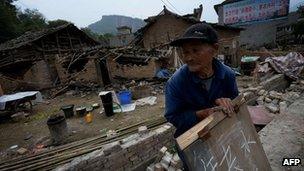China's Red Cross fights to win back trust
- Published

The magnitude 7.0 quake destroyed homes and killed at least 188 people
Following Saturday's Sichuan earthquake, the appeal from the Chinese Red Cross, the country's largest charity, seemed fairly straightforward.
"The quake zone urgently needs tents, quilt, instant food, drinking water and medical goods," the charity posted to Weibo, China's version of Twitter. "Please try your best to donate cash."
In response, hundreds of thousands of people quickly posted emoticons giving the government-run charity a literal thumbs-down.
"People around me are all hesitating whether to donate to the earthquake zone," wrote online user Li Yapingww. "They don't know if their hard-earned money can reach the victims."
Another user, named "Lao Xu", was enraged by a photo of Chinese Red Cross employees in the quake zone. "They're eating instant noodles while wearing expensive watches. These photos are just asking for criticism."
Designer watches are at the tip of the charity organisation's image problem: the organisation has yet to recover from a series of scandals that began after the Sichuan earthquake in 2008.
Back then, the Chinese Red Cross was designated as one of two charities that could legally accept donations. Smaller organisations were told to funnel their donations to their larger counterparts.
Tarnished reputation
According to China's state-run media, over $12.4 bn US dollars (£8.1 bn) in goods and services were donated to quake victims in the year after the 2008 Sichuan quake.
However, the charity's reputation was soon tarnished. Some monitoring the quake's rebuilding efforts accused Red Cross officials of misusing donations by purchasing needlessly expensive tents and vehicles, though those allegations were denied.

Rescue workers have struggled to reach remote places
In 2009, researchers at Tsinghua University revealed that 80% of charitable donations after 2008's Sichuan earthquake were funnelled into Chinese government coffers as "extra revenue".
At the time, some contended this was appropriate, since the government was best equipped to rebuild the quake zone.
Others complained the Red Cross donations would be impossible to track, leading to fears of corruption.
In April 2011, revelations of an extravagant banquet attended by Red Cross officials costing almost 10,000 yuan ($1,600; £1,050) spurred criticism online. The amount is considered high within China, especially for employees of a charity. Officials apologised and offered to foot part of the bill themselves.
Months later, the organisation was decimated by a much bigger scandal when a glamorous young woman calling herself "Guo Meimei" posted online photos of herself posing with luxury cars and designer handbags.
Ms Guo boasted that she was the "general manager" of the China Red Cross Commerce Department - a commercial organisation with murky links to the charity.
It turned out that Ms Guo had inflated her own title, but the damage had already been done: many donors had scrutinised the photos of Guo's extravagant lifestyle and had concluded that the Red Cross was wasting their money.
That year, the charity registered a 60% drop in private donations.
'Blindly cursing'
"At the moment, many Chinese people are hostile to government officials and rich people," explains Jia Xijin, deputy professor of public management at Tsinghua University.
"So now, they've also started to question government-sponsored institutions."
The Chinese Red Cross has been trying to reform its image. Last December, the Chinese Red Cross formed a 16-member committee to improve its transparency.
Most concerned citizens don't have any other choice but to trust the Chinese Red Cross with their earthquake donations, since once again, the charity is one of the only organisations that can receive money for victims of the current crisis.
"I don't believe in the Red Cross, but I choose to believe those who participate in the rescue work on the front line. They need to be respected," rationalises Weibo user Juan er.
"Those who are corrupt are the top officials and those who suffer are the people at the bottom. Blindly cursing at people won't prove how moral you are."
- Published22 April 2013
- Published21 April 2013
- Published5 July 2011